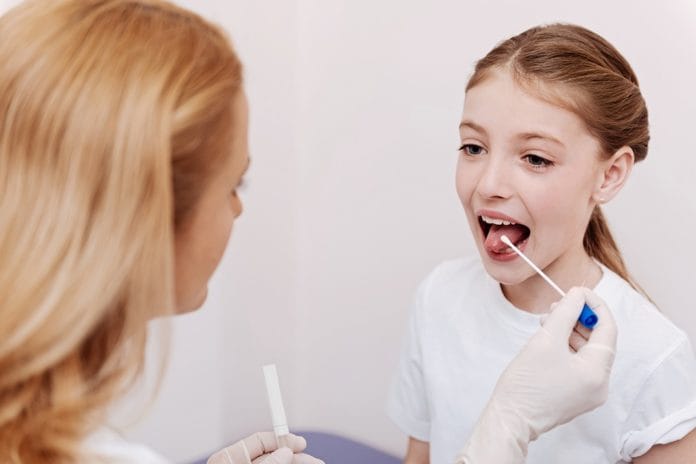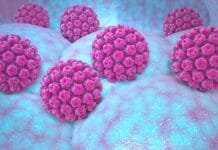During dental treatment, saliva is generally not our friend. We fight with it to keep patients from feeling like they are drowning, it is always interfering with sealant placement and other restorative procedures, but what if that saliva we loathe could help our patients with early disease diagnosis? The ability to utilize saliva to monitor the health and disease state of an individual is a highly desirable goal for health promotion and health-care research. However, saliva diagnostics is a ‘late bloomer,’ since only recently has there been a growing appreciation of saliva as a mirror of the body, which can reflect virtually the entire spectrum of normal and disease states.1
In the past, getting a diagnosis would require a trip to the doctor’s office or hospital. The examinations often involved providing a blood or tissue sample. Collection of these samples were invasive involving needles and/or cutting away a small area of the tissue for a biopsy. The blood or tissue samples were labeled and sent to a laboratory for testing. Typically, patients waited several days for the results. In many cases, they needed to schedule a follow-up visit for additional, often expensive, tests that further narrowed down the possible diagnosis. Most tests detected full-blown disease. Few were sensitive enough to detect subtle biochemical changes that might indicate a developing health condition.2
The good news is times are changing and currently available are salivary diagnostic tests including various hormonal, HIV, and alcohol tests. Each test requires a small amount of saliva and produces rapid and highly accurate results.2 Scientists are hard at work identifying biomarkers in saliva which include genetic material (such as DNA and RNA) and protein molecules that reflect the current physiological state of an individual. Studies have revealed distinct advantages of saliva over serum. Like serum, saliva also contains hormones, antibodies, growth factors, enzymes, microbes and their products. Many of these constituents enter saliva through blood via passive diffusion, active transport, or extracellular ultra-filtration. There have been concerns about the use of saliva for diagnostic purposes due to its low concentration of analytes in comparison to blood. However, with the advent of highly sensitive molecular methods and nanotechnology, this is no longer a limitation.3
Salivary diagnostics are available for oral disease and oral cancer. According to the CDC, approximately 91% of US adults aged 20-64 had dental caries in permanent teeth in 2011-2012.4 Many studies have demonstrated the role of S. Mutans in initiating dental caries, while Lactobacilli plays a role in the progression of carious lesions. High salivary levels of both pathogens using a commercially available test have shown a positive association with the presence of caries in children and adults.3 This information could be useful in determining risk factors to predict individuals at risk for caries. It would help reinforce the importance of preventive care, as well as adjunct services such as fluoride treatments and sealants, to reduce the risk of caries.
The American Academy of Periodontology warns of a significant public health problem. Using data from the CDC, it is estimated that 47% of US adults have periodontal disease. Among those individuals, 38.5% have moderate or severe periodontitis.5 Various salivary biomarkers have been studied for the diagnosis and prognosis of periodontal diseases. These include inflammatory mediators, enzymes, epithelial keratins, immunoglobulins, salivary ions, and hormones. Investigators have found that higher salivary levels of Porphyromonas gingivalis, Tannerella forsythia, and Prevotella intermedia were found in individuals with progressive periodontitis. This phenomenon has also been noted by a recent study, which shows that the combination of salivary P. gingivalis quantity with host-specific pathogen response would be useful in diagnosing periodontitis with high accuracy.3
Using the information from a salivary test to treat periodontitis could make a more individualized treatment plan. Having test results before and after non-surgical perio therapy, such as SRP, would help to decide on the next course of treatment, such as local vs. systemic antibiotic treatment, or probiotic supplement to bring the patient back to a healthy state. Another benefit to consider is salivary testing might prevent insurance companies from denying treatment if the patient has a diagnosis from lab results.
In addition to saliva being a source of bacterial diagnostics, it has also been successfully used as a diagnostic tool to assess risk for oral cancer. Oral squamous cell carcinoma (OSCC) is the most common form of oral cancer. The key to decrease OSCC mortality and morbidity is early detection. However, in asymptomatic patients, there is insufficient evidence to determine whether a visual and tactile oral screening test or commercially available oral cancer screening methods (such as autofluorescence, tissue reflectance, or transepithelial cytology) will prevent oral cancer-related mortality. Therefore, other non-invasive screening options are needed.
Several research groups have found that salivary levels of specific proteins are increased in whole saliva of patients with OSCC. A test is commercially available in the US and Canada for identifying individuals who are at risk of developing OSCC on the premise that 60% of OSCC tumors are associated with HPV-16.3 HPV-related cancers have replaced smoking and alcohol cancers many times over. The CDC states HPV is thought to be the cause of 70% of oropharyngeal cancers in the US.6 HPV oral infection is increasing 30% per year, with 50% of those cases occurring in 15-24-year-old individuals, affecting males more than females.7
Salivary diagnostic testing for caries, periodontal disease, HPV, and HIV are available for use. Some studies are researching the possible use in diagnosing other diseases as well. Though these tests need further clinical trials to receive FDA approval, we may see more salivary diagnostic tests available for commercial use for a variety of diseases. Autoimmune disorders such as Sjogren’s syndrome and Cystic fibrosis are being researched. Current tests for Sjogren’s syndrome include salivary flow rate determination, salivary scintigraphy, sialography, serological tests or minor salivary gland biopsies. Although useful, these tests are invasive, expensive or in many cases non-conclusive. Salivary proteomics represents a valuable tool to diagnose Sjogren’s syndrome. It is based on several biomarkers that are simultaneously influenced by the disease.3
Cardiovascular disease is another disease that could use salivary diagnostics in the future. Cardiovascular disease is the leading cause of death in the US.8 A significant number of patients suffering from heart disease lack known risk factors such as family history, hypertension, and increased lipid profiles. Similarly, unlike subjects with high serum cholesterol levels, people with increased C-reactive protein are more likely to be unaware of their susceptibility to developing cardiovascular disease. Salivary C-reactive protein levels were found to correlate with plasma C-reactive protein levels obtained from blood samples of a population at risk for cardiovascular complications. It is also possible to detect cardiac troponin, a biomarker for the detection of acute myocardial infarction in saliva that is released in response to cardiac cell necrosis.3
From an oncology viewpoint, validating markers for a variety of cancers such as breast cancer, lung cancer, and gastric cancer among others, is an extremely important tool for early diagnosis and in turn a higher survival rate for cancer patients. The first salivary biomarker for cancer to be discovered was the HER2/neu for breast cancer. Cancer antigen 15-3 (CA 15-3) is a prognostic marker for breast cancer given that levels appear higher when compared to the results of healthy patients, a positive correlation between serum and salivary levels of CA 15-3 was discovered.9
Recently, a breakthrough study on using salivary diagnostics for early diagnosis of mild cognitive impairment and Alzheimer’s disease was published. According to the CDC, 5.4 million Americans are affected by this disease. It is the sixth leading cause of death among all adults and the fifth leading cause for those aged 65 or older.10 The Alzheimer’s disease process is likely initiated many years before clinical onset. Biomarkers for preclinical disease are critical for the development of disease-modifying or even preventative therapies.
During this study a new, single saliva biomarker, lactoferrin, was discovered and validated, via cross-sectional investigation, it perfectly discriminates clinically diagnosed amnestic mild cognitive impairment and Alzheimer’s disease patients from a cognitively healthy control group. The accuracy for Alzheimer’s disease diagnosis shown by salivary lactoferrin was greater than that obtained from core cerebrospinal fluid biomarkers. Furthermore, salivary lactoferrin can be used for population screening and for identifying those underdiagnosed subjects with very early stages of mild cognitive impairment and Alzheimer’s disease.11 Other diseases with great promise for salivary diagnostics include Type 2 diabetes, celiac disease, endocrinopathies, Cushing’s syndrome, pancreatic cancer, ovarian cancer, and melanoma.
I’m sad to report although the salivary tests for bacterial and viral infections are available, and many others are being developed, the use of these tests by dental professionals has been limited. It was reported in 2008, 19.5 million people did not visit a general health care provider, but did visit a dental care provider.12 Often, patients visit the dentist more often than they visit their general health care provider. Implementing salivary diagnostic testing could potentially help with early diagnosis and treatment of diseases. Dental professionals, it is time to step up to the plate. This is an amazing opportunity to start the process of breaking down that barrier between medical and dental professionals. It’s time to make advancements and offer better care for our patients.
SEE ALSO: Ask Kara RDH: Co-worker Underdiagnosing & I Have to Explain to Patient
DON’T MISS: Periodontal Maintenance: Taking the Guesswork out of the 4910
Resources
- Prabhakar AR, Akanksha Gulati, Deepak Mehta, S Sugandhan. Diagnostic Applications of Saliva in Dentistry. Int J Clin Pediatr Dent. 2009 Sep-Dec; 2(3): 7-13. Retrieved from: https://www.ncbi.nlm.nih.gov/pmc/articles/PMC4086572/
- National Institute of Health. Salivary Diagnostics Fact Sheet. Retrieved from: https://report.nih.gov/nihfactsheets/ViewFactSheet.aspx?csid=65
- Mohammad A. Javaid, Ahad S. Ahmed, Robert Durand, Simon D. Tran. Saliva as a diagnostic tool for oral and systemic diseases. J Oral Biol Craniofac Res v.6(1); Jan-Apr 2016. Retrieved from: https://www.ncbi.nlm.nih.gov/pmc/articles/PMC4756071/
- Centers for Disease Control and Prevention. Retrieved from: https://www.cdc.gov/nchs/products/databriefs/db197.htm
- American Academy of Periodontology. Retrieved from: https://www.perio.org/consumer/cdc-study.htm
- Centers for Disease Control and Prevention. Retrieved from: https://www.cdc.gov/cancer/hpv/basic_info/hpv_oropharyngeal.htm
- Centers for Disease Control and Prevention. Retrieved from: https://www.cdc.gov/cancer/hpv/statistics/trends/index.htm
- Centers for Disease Control and Prevention. Retrieved from: https://www.cdc.gov/nchs/fastats/leading-causes-of-death.htm
- Silvia Marti-Alamo, Aisha Mancheno-Franch, Cristina Marzal-Gamarra, Laura Carlos-Fabuel. Saliva as a diagnostic fluid. Literature review. J Clin Exp Dent. 2012;4(4):e237-43. Retrieved from: https://www.ncbi.nlm.nih.gov/pmc/articles/PMC3917631/
- Centers for Disease Control and Prevention. Retrieved from: https://www.cdc.gov/chronicdisease/resources/publications/aag/alzheimers.htm
- Eva Carro, Fernando Bartolome, Felix Bermejo-Pareja, Alberto Villarejo-Galene, Jose Antonio Molina, Pablo Ortiz, Miguel Calero, Alberto Rabano, Jose Luis Cantero, Gorka Orive. Early diagnosis of mild cognitive impairment and Alzheimer’s disease based on salivary lactoferrin. Alzheimers Dement (Amst) v.8; 2017 Retrieved from: https://www.ncbi.nlm.nih.gov/pmc/articles/PMC5470603/
- Paul L.A.M. Corstjens, Dr. William R. Abrams, Dr. Daniel Malamud. Detecting viruses by using salivary diagnostics. J Am Dent Assoc. 2012 Oct: 143(10 0): 12S-18S. Retrieved from: https://www.ncbi.nlm.nih.gov/pmc/articles/PMC4262792/











